Have you spotted social media ads or websites advertising unbelievable deals on Pandora jewelry like 90% off charms, bracelets, and rings? As tempting as the blowout prices seem, these viral promotions claiming to be from Pandora are an elaborate ruse designed to scam shoppers.
Read on to uncover how these sophisticated jewelry scams work and how to avoid becoming a victim. You’ll learn the telltale signs across sham websites, Facebook ads, Instagram posts, and more that expose the fake clearance sales. Don’t let the lure of deep discounts on Pandora pieces lead you into deceptive traps set up by opportunistic fraudsters.
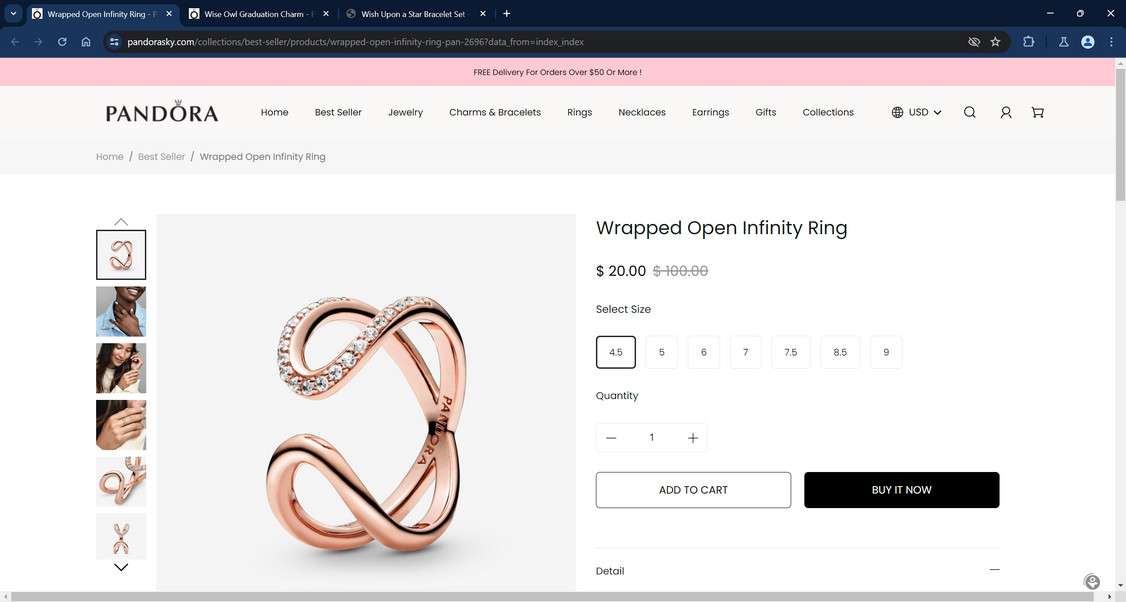
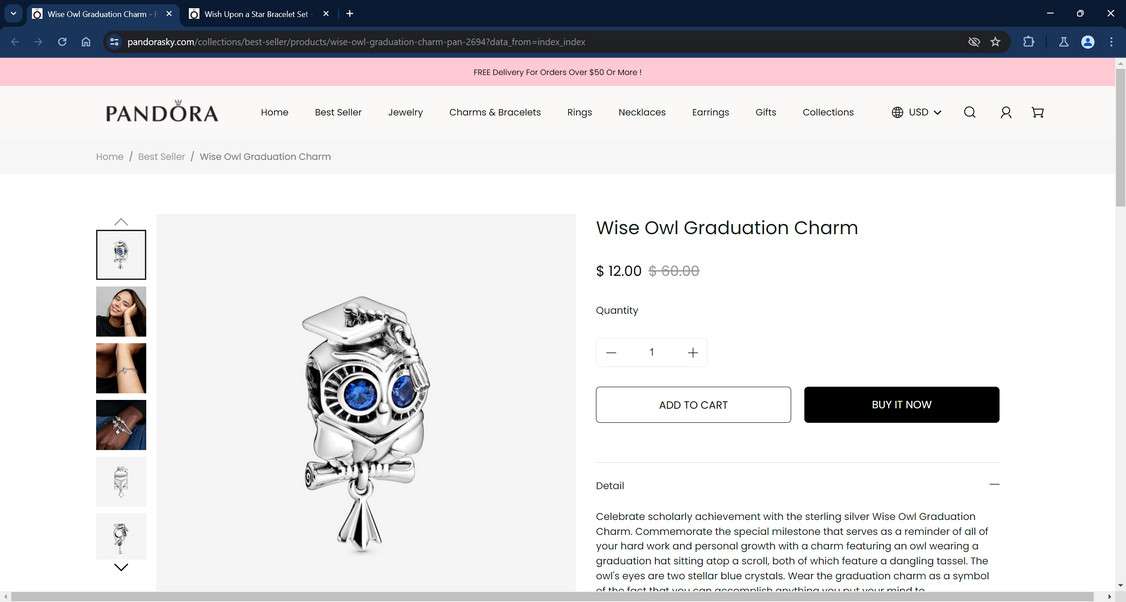
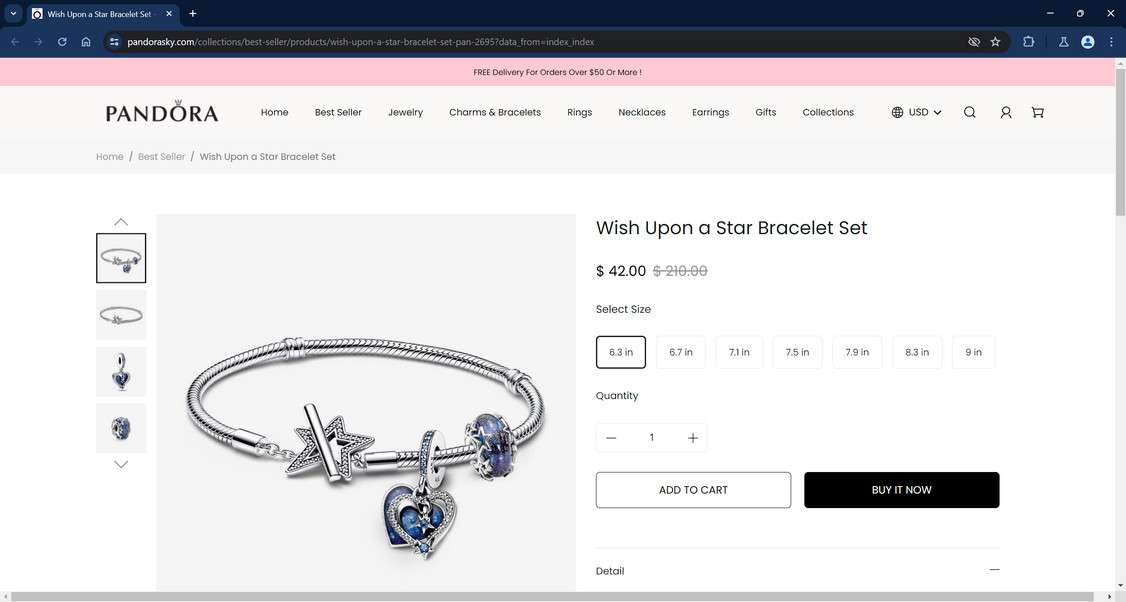
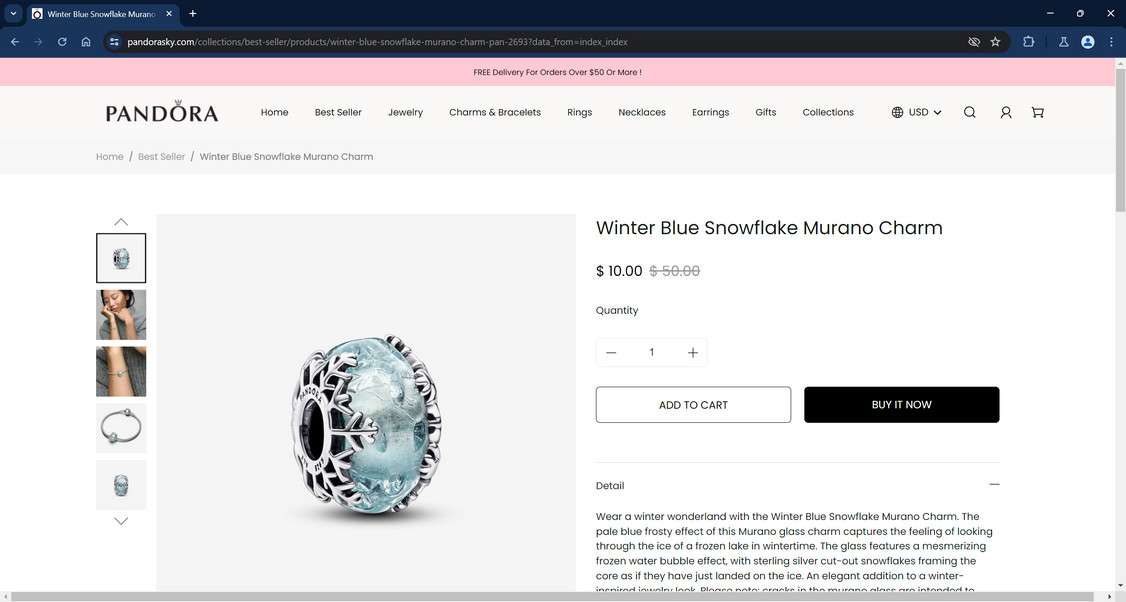
This Article Contains:
An Overview of the Pandora Clearance Sale Scam
The Pandora name is coveted globally for their popular customizable bracelets, charms, necklaces, and other jewelry items. Scammers seek to hijack this reputation by creating imitation websites, social pages, and online ads that closely resemble Pandora’s official branding and shopping experience.
These fake outlets feature the familiar sleek white theme, Pandora logo “P”, high-resolution jewelry images, and promotions for new collections just like the real site. Many also contain “Pandora” directly in the website URL to appear valid.
The scam pages lure visitors with claims of blowout markdowns like “Up to 90% off” and “Pandora closing sale”. Prices are shown at unbelievably low rates, such as $500 bracelets for $29, $300 rings for $49, and $100 charms for just $9.
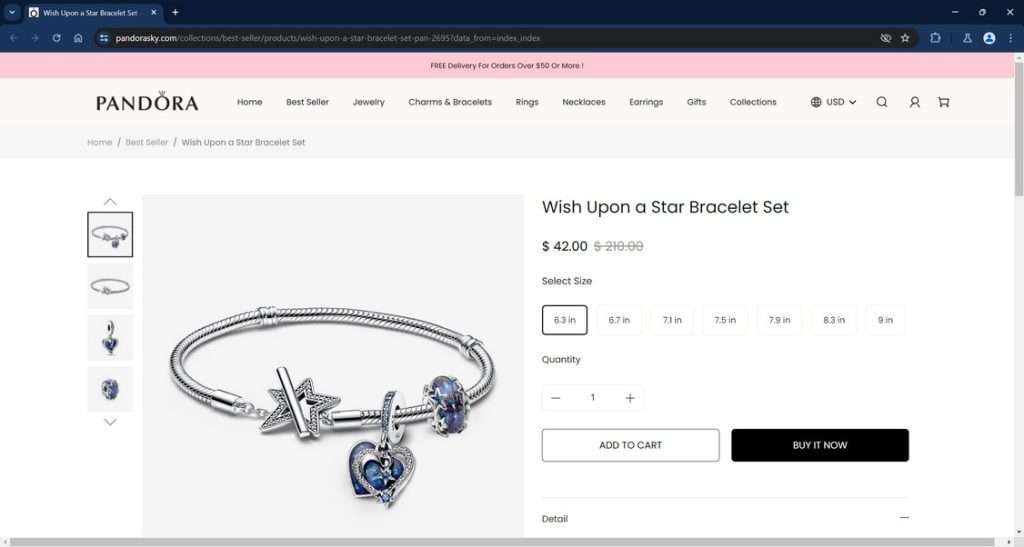
Of course these near-free prices are bogus and the first red flag of a counterfeit site. But scammers bank on Pandora’s trusted name to convince shoppers the liquidation deals are real.
The fake sales also spread through sponsored posts on Facebook, Instagram, and TikTok. Fraudsters pay to promote Pandora ads with language about clearance events, limited inventory, and going out of business discounts.
When social users click these compelling ads they are sent to the network of sham sites the scammers built specifically to steal money and information. Shoppers add items to their carts thinking they scored big savings, but no orders are ever fulfilled.
At best, victims may receive cheap, poor quality imitation jewelry instead of the authentic Pandora pieces they paid for online. The criminals pocket any payments rather than ship out real Pandora products.
By mimicking Pandora’s iconic branding and dangling hard to pass up deals, the scammers dupe countless consumers. But learning their tactics makes it possible to avoid getting tricked by fake discount offers.
How the Elaborate Pandora Jewelry Scam Works to Deceive Shoppers
The criminals running these fake Pandora clearance scams go through a number of calculated steps to successfully pull off their bait-and-switch jewelry ploy:
1. Building Convincing Imitation Pandora Websites
The scammers invest heavily in creating imitation Pandora websites featuring the same sleek white theme, logo fonts, and overall design as the real Pandora.com site.
They typically incorporate “Pandora” directly in the URL, along with extra keywords like “outlet”, “store”, or “shop” such as:
- PandoraJewelryOutlet.com
- PandoraBraceletsShop.com
- PandoraCharmStore.net
The fake sites are populated with beautiful high-resolution images of rings, necklaces, charms and more stolen directly from Pandora’s ecommerce catalog without authorization.
To the average visitor, the impersonator sites appear as legitimate Pandora jewelry stores selling all their popular collections at steep markdowns.
2. Promoting Fake Online Sales Through Social Media Ads
Once the network of convincing fake sites is ready, the fraudsters launch large-scale advertising campaigns on platforms like Facebook, Instagram, and TikTok.
The social media ads target women who follow jewelry accounts, shop online frequently, and seem inclined to hunt for sales.
The ads tout attention-grabbing blowout deals on Pandora items, using language around “clearance”, “going out of business”, and “limited inventory”.
For example, a $300 Pandora ring advertised for just $49 or a $100 charm bracelet bundle for only $29. These compelling ads aim to drive traffic to the scam websites.
3. Duping Bargain Shoppers with Deals That Seem Legitimate
When social media users click on these ads, they are sent to one of the fake Pandora websites specifically created for this scam. Unaware it’s an imposter site, visitors browse what looks exactly like an authorized Pandora jewelry outlet.
They see the familiar logo and branding along with steep discounts up to 90% off rings, necklaces, earrings and more thanks to the promoted “blowout sale”.
Prices like $500 bracelets for $39, $300 charms for $19, or $100 earrings for $9 seem plausible given Pandora is known for sales. So victims trust the sites and make big purchases.
The criminals also create urgency around the deals selling out quickly to pressure shoppers into buying faster.
4. Stealing Credit Cards and Money from Duped Shoppers
Once a customer adds enough items to their cart at the huge markdowns and proceeds to checkout, they enter personal and credit card details – never realizing the site is an intricate scam.
The fake payment forms and confirmation screens closely mimic the real Pandora site to complete the ruse. Victims receive order emails but no real Pandora jewelry ever ships out.
At best, some may receive poor quality counterfeit Pandora charms or bracelets rather than the real pieces they purchased online. Either way, the scammer gets the money while the shopper is left with nothing.
5. Staying Steps Ahead of Detection
Before a particular phony Pandora website gains too much exposure, the scammers quickly launch dozens more with slightly tweaked names.
They continually register new domains and initiate fresh waves of social media ads to keep their bait-and-switch operation constantly churning and evade blacklisting efforts.
This constant evolution enables the criminals to successfully dupe massive numbers of jewelry shoppers seeking big savings on Pandora products. They exploit blind spots in skepticism around deals that seem just legitimate enough.
By meticulously mirroring the real brand, the scammers play to people’s tendency to let guard down when temporarily overwhelmed by compelling offers from trusted names.
How to Identify the Fake Pandora Websites
While the criminals behind these jewelry scams try hard to copy the real Pandora website, their sham pages do contain certain red flags that can reveal them as fraudulent:
Recently Registered Domain Names
A quick domain registration check often shows these phony Pandora sites were just created within the past few months.
The scammers constantly put up new websites to rip people off, then ditch them once exposed. A recent registration date is a major warning sign.
Suspicious URLs Trying to Mimic Pandora
The website URLs themselves tend to be tipoffs, as they try appearing almost identical to Pandora.com through slight modifications.
Watch for extra terms like “Official”, “Shop”, or “Outlet” in the URL:
- PandoraCharmShop.com
- PandoraBraceletOutlet.net
- OfficialPandoraStore.org
Basically any URL besides the real Pandora.com domain should be treated with serious caution before entering info.
Plagiarized Website Content
The fake sites feature Pandora’s clean white template and organizing categories, but lack unique content written specifically for Pandora.
All the jewelry photos, product descriptions, and pricing are stolen straight from Pandora.com illegally. A real retailer would never completely plagiarize content.
Implausible Discount Levels
Obviously the biggest red flag is deals too good to be true like 90% off the latest charm bracelets or $300 rings for $29.
Other dubious terms used are “limited time only” and “going out of business” to create false urgency around the unrealistic deals.
No Contact Information Beyond Email
Highly suspicious indicators are no phone number, physical address, or other valid contact info beyond an email address.
This allows scammers to avoid revealing themselves while still collecting data through order forms. No actual retailer operates without multiple contact methods for shoppers.
Applying extra scrutiny helps spot subtle but consistent patterns across the growing number of fake Pandora websites seeking to lure bargain seekers. Use caution before handing over information or money.
How to Detect the Fake Pandora Ads on Social Media
In addition to the network of sham websites, a big part of this scam involves fraudulent social media ads. Learning their common characteristics helps avoid falling for them.
Spotting Deceptive Facebook Ads
The Facebook ads mimic real Pandora promotions with their logo, jewelry visuals, and captions about clearance sales. But some signs indicate it’s a scam ad:
- Prices too good to be true like 90% off
-Posts have comments disabled - Page name contains “Official” or “Outlet”
- Links go to fake sites instead of Pandora.com
- High pressure tactics around limited stock
For example, a Facebook ad may promote a $500 Pandora bracelet discounted to $39! But the implausibly low price is a dead giveaway it’s fraudulent bait.
Identifying Fake Instagram Ads
On Instagram, the scammers create posts of Pandora jewelry with huge sale claims like “Entire store 90% off for 24 hours only!” using eye-catching fonts and colors.
But it’s likely an Instagram scam if:
- Brand new account with only sale promotions
- No contact info provided
- Username contains “Deals” or “Sales”
- Links go to shady URLs instead of Pandora.com
- Users can’t comment on the posts
Think twice before clicking Instagram ads about blowout Pandora sales from accounts you don’t already know.
Recognizing AI-Generated Scam Videos on TikTok
On TikTok, the fraudsters post short AI-generated videos of “customers” shopping big Pandora sales inside fake stores. But it’s easy to tell it’s not real:
- Brand new account
- Implausible discounts promoted
- Shows no real people or locations
- Comments turned off
- Links go to phony sites
The artificial jewelry store videos solely exist to direct viewers to the network of scam websites. No genuine TikTok user is behind them.
Apply extra diligence to avoid getting tricked by unbelievable social media jewelry deals that seem just legitimate enough. Validate before clicking or providing any personal information through them.
What to Do if You Are Scammed By a Fake Pandora Sale
If you placed an order or provided payment information on one of the fraudulent websites or ads, take these steps to address the situation:
1. Contact Your Credit Card Provider Immediately
Inform your credit card company you suspect fraud and start a chargeback case. Provide any transaction records that show you never got the items.
2. Report Fake Sites to the Real Pandora
Contact Pandora to inform them of any counterfeit websites you encountered misusing their name and branding illegally.
3. Reset Any Passwords Used on the Fake Sites
Change the passwords immediately on any of your accounts that you used on the scam websites as a precaution. Enable two-factor authentication as well.
4. Place Fraud Alerts on Your Credit Reports
Contact the credit bureaus to place 90-day fraud alerts on your credit reports to prevent identity theft if your information is compromised.
5. Monitor Your Credit Card Statements Closely
Watch statements routinely for any unauthorized charges and report any suspicious activity to your bank right away before it compounds.
6. File Complaints With Relevant Agencies
Submit official complaints regarding the scam websites and ads to the FTC, state attorney general, IC3, BBB, and other consumer protection groups.
7. Warn Others About the Fake Pandora Sales
Share your experience across social media channels and consumer posting sites to make others aware of the dangerous clearance sale scam plaguing Pandora.
Taking quick action helps minimize damages from providing data to deceitful sites and reduce risks of further identity theft. Greater awareness about common online shopping scams protects more consumers too.
Frequently Asked Questions About the Pandora Jewelry Scam
1. Are the Pandora clearance sales I see online for 90% off real?
No. Any promotions offering Pandora jewelry at absurdly low prices like 90% off are fake. Pandora runs legitimate sales occasionally but prices that seem too good to be true always indicate a scam.
2. What happens if I order from the fake Pandora websites?
Your credit card will likely be charged but you’ll never receive the Pandora items you ordered. At best you may get low-quality counterfeit jewelry instead of authentic Pandora products. Either way, you lose money and get nothing close to the advertised deal.
3. How can I tell a fake Pandora website from the real one?
Watch for red flags like recently registered domains, lack of contact info, unbelievable prices, stolen images, and “Official” or “Outlet” in the URL. See the “How to Spot Fake Sites” section above for a full list of indicators.
4. Does Pandora authorize these fake online sales?
No. Pandora does not benefit from or authorize these sham websites misusing their branding and name to scam shoppers. Pandora actively works with authorities to shut down fake sites and social media accounts.
5. Is it illegal to buy from the fake Pandora websites?
While knowingly purchasing counterfeit goods is illegal, the victims of these jewelry scams are generally not the ones who face prosecution – the criminals running the sites do.
6. How can I get my money back if scammed?
Immediately contact your credit card company and request a chargeback for any unauthorized charges. Provide any evidence you have showing the items were never delivered.
7. What’s the best way to report a fake site?
Use the real Pandora contact information to notify their security team of any scam sites misrepresenting themselves as Pandora. You can also file complaints with the FTC.
8. How can I avoid getting tricked by these scams?
Only purchase Pandora products through the official Pandora.com website and verified authorized retailers. Be very wary of unrealistic discounts and always verify site legitimacy before providing payment information or ordering.
9. Why does Pandora attract so many fake sales?
Pandora’s popularity as a jewelry brand makes them a prime target for scammers seeking to exploit their reputation and dupe shoppers who trust the name. Big discounts on coveted items draw more victims in.
10. Do other jewelry brands face this type of scam?
Yes, fake online sales scams also frequently target brands like Tiffany & Co., Swarovski, and Cartier. Always carefully scrutinize unbelievable deals no matter the retailer.
Be vigilant and only trust the real Pandora.com website to avoid falling victim to the many fake discount offers. Educating yourself protects against online scams.
The Bottom Line – Verify Before Shopping Any Sales
The extreme markdowns like 90% off the latest Pandora bracelets or charms for $9 should set off instant warning bells. But scammers bank on temptation overriding caution when faced with deals too good to be true.
This makes it critical we override wishful thinking and carefully scrutinize suspicious Pandora promotions before providing any sensitive information or payment data. Take time to verify site legitimacy.
With expert jewel counterfeits abounding, exercise extra care when dazzling discounts seem totally implausible, even from a trusted brand like Pandora. Avoid getting duped by only using Pandora’s official online store for all purchases.
Staying vigilant for common online scam red flags and ignoring emotional impulse responses goes a long way to shopping more intelligently and stopping fraud in its tracks. We can dismantle these criminal networks if we educate ourselves on their underhanded bait-and-switch tactics. Don’t become yet another victim of sham jewelry sales preying on loyal shoppers and their desire for great deals.










